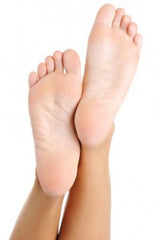
Cracked heels are common in both men and women, especially during the winter months. While this pesky and often painful problem is often ignored, it is important to take steps to protect your feet and heels in order to prevent a more serious and long-term problem.
What causes cracked heels?
When the bottom of your feet and heels become dry, the sensitive skin on your heels can split open causing painful cracks called fissures. Without allowing these fissures to heal, they can split further open and become even deeper, which can cause bleeding and infection.
Cracked heels are more common in the dry, winter months and can be caused by a variety of factors, including irritated skin conditions like psoriasis, diabetes, dehydration, poor nutrition and obesity. Bad shoes and high impact exercises, such as running, may exacerbate the problem.
Here are 8 easy ways to care for and prevent cracked heels:
1. Moisturize, moisturize, moisturize. Moisturize your skin with a good, oil-based lotion, balm or cream regularly. Consider applying moisturizer and then cotton socks before going to sleep to hold in moisture and wake up with softer feet. We always recommend choosing all-natural product to avoid skin irritation.
2. Drink plenty of water. It is very important to drink enough water to make sure that your body is staying hydrated.
3. Change your exercise routine (at least temporarily). There is no doubt that running and high impact exercise can aggravate cracked heels. Consider switching up your workout routine until your heels heal. Try walking or bike riding instead.
4. Use a pumice stone to remove dead skin cells. Pumice stones are often recommended to slough off dry, dead skin. However, it is important to be gentle and avoid irritated areas where you may already have cracks to prevent further irritation or infection.
5. Invest in comfortable shoes. While we all love to look our best in fashionable shoes, comfort and adequate support is key to protecting your feet and heels – especially if you spend a lot of time on your feet.
6. Modify your diet. There is no doubt that maintaining a healthy diet benefits your skin – all the way down to your feet and heels. Make sure that your diet is rich in vitamins and minerals to promote healthy skin.
7. Turn on a humidifier. During the winter months, the air tends to be much drier making you skin much drier. Consider using a humidifier in your home which tends to dry out your skin.
8. Consult a doctor. We always recommend talking to a doctor about any pain or discomfort you are experiencing. If you think you are developing an infection or the condition is not improving, consult a doctor right away.

Leave a comment